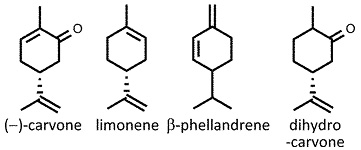 Mentha spicata
Mentha spicata
spearmint • garden mint
Back to “Salad herbs and herb mixtures: garden mint (Mentha spicata); spearmint (Mentha spicata)”
Back to “Culinary herbs: garden mint (Mentha spicata)*; spearmint (Mentha spicata)*”
Mentha spicata L. (Lamiaceae); kruisement (Afrikaans); naana (Arabic); kruizemunt (Dutch); menthe verte, menthe douce (French); Grüne Minze, Krauseminze (German); menta verde, menta ricciuta (Italian); supea minto (Japanese); hortelã-comun (Portuguese); menta romana (Spanish); grön mynta, krusmynta (Swedish); húng dũi (Vietnamese)
DESCRIPTION Leaves are broad, hairless and bright green, with toothed margins and prominent veins giving a wrinkled appearance. The leaves emit a strong spearmint smell even when lightly touched.
THE PLANT A hardy perennial herb with creeping rhizomes and erect flowering stems of up to 0.6 m (2 ft) high. White flowers are borne in terminal spikes. A form known as Bowles’s mint is a backcross with a M. ×villosa hybrid.1 Ginger mint, also known as Scotch spearmint (M. ×gracilis, previously known as M. cardiaca) has large, often variegated leaves and is chemically similar to spearmint, of which it is a hybrid (with M. arvensis).1 Spearmint is similar to horse mint or longleaf mint (M. longifolia) but the leaves are much broader, and also to apple mint or woolly mint (M. suaveolens) but it lacks hairs. A decorative form with variegated leaves is known as pineapple mint (M. suaveolens ‘Variegata’). Round-leaf mint (M. ×rotundifolia) is probably merely a form of M. suaveolens. Water mint (M. aquatica) has rounded (not spike-like) inflorescences.
ORIGIN Spearmint is a European garden hybrid between M. suaveolens and M. longifolia.1 It became popular because of its distinctive aroma and is today an important commercial crop in the essential oil industry.
CULTIVATION Plants are easily grown from cuttings and flourish in rich, moist soil. It is one of the most commonly grown culinary herbs. Commercial cultivation is centred in the United States (Washington State).2
HARVESTING Vigorous young leafy shoots are hand-picked and rapidly delivered to fresh produce markets. For spearmint oil production, mechanical methods are used.2
CULINARY USES Mint is best known as the essential component of mint sauce or mint jelly, the traditional accompaniment for roast leg of lamb in England. It is included in beverages, sherbets, soups, stews, sauces, vinegars, veal, fish, beef, yogurt, green peas, spinach, carrots, eggplant and boiled potatoes.2 Mint tea is a popular drink made from fresh or dried mint leaves, sweetened with honey and served hot or cold with a slice of lemon. Mint julep is a famous southern USA (Kentucky) cocktail made with spearmint leaves, bourbon, sugar and crushed ice.
FLAVOUR COMPOUNDS Spearmint oil is dominated by (–)-carvone (more than 50%),3 which gives it the typical (non-cooling) spearmint flavour. Also present are limonene, phellandrene and dihydrocarvone.3 It is interesting to note than (+)-carvone, the major flavourant of caraway (Carum carvi), has a quite different smell. The level of carvone appears to be higher from spring to autumn, with limonene exceeding carvone in winter.4 Commercial Scotch spearmint oil has carvone and limonene as main compounds.5

NOTES Spearmint oil is used mainly in chewing gum, sweets, confectionery, ice cream, cordials, toothpaste, oral hygiene products and tobacco.
1. Mabberley, D.J. 2008. Mabberley’s plant-book (3rd ed.). Cambridge University Press, Cambridge.
2. Farrel, K.T. 1999. Spices, condiments and seasonings. Aspen Publishers, Gaithersburg, USA.
3. Harborne, J.B., Baxter, H. 2001. Chemical dictionary of economic plants. Wiley, New York.
4. Benyoussef, E.-H., Yahiaoui, N., Khelfaoui, A., Aid, F. 2005. Water distillation kinetic study of spearmint essential oil and of its major components. Flavour and Fragrance Journal 20: 30–33.
5. Kothari, S.K., Singh, U.B. 1995. The effect of row spacing and nitrogen fertilization on Scotch spearmint (Mentha gracilis Sole). Journal of Essential Oil Research 7: 287–297.